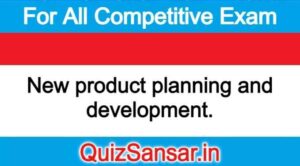
New product planning and development.
Introduction to New Product Planning and Development (PPD) New product planning and development embraces all activities which start with the idea generation and ends with its full-scale commercialisation in the market, or modification of existing products to add stability.
It is basically concerned with getting ideas for new products, screening them, and translating them to tangible shapes through systematic research and development and then producing the products on a mass scale for marketing at a profit.
Thus, the whole process of new product development requires close co-ordination with other planning areas within a company. Because of this, it must be centralised as shown in the diagram below, whether by assigning responsibility for it to the Product Design and Development Manager or a distinct department reporting to the top management or an executive in the marketing organisation.
Circumstances Leading to PPD:
New product planning and development has become an increasingly important part of business operations as companies strive:
(i) To stay ahead of changing customer requirements and preferences,
(ii) To keep pace with fast-moving technology, and
(iii) To match the new product entries of competitors.
PPD becomes necessary for the following circumstances:
(1) To replace the short-lived products,
(2) To arrest a fall in the rate of firm’s growth,
(3) To utilise surplus funds or surplus capacity, and
(4) To modify or improve the existing products with a view to adding stability to them.
Essential Elements of PPD:
The essential elements or prerequisites to PPD can be summarised follows as:
(1) Research and Design: These include market research, product research, and analysis of the alternative designs and characteristics for finalising the one that would meet the customer requirements and be able to capture mass market.
(2) Production Technique: This requires examination of the alternative techniques of production, and choosing the right one that would necessarily add such attributes to a product which match the customers’ needs.
(3) Modification and Improvement: These include in-depth analysis and final decision-making for modifying and improving the existing products in terms of specification, quality, novelty, packaging, etc.
(4) Product Elimination: This requires a decision to drop the unprofitable products from the firm’s range of products so as to divert the resources to profitable products.
(5) Product Pricing: This involves a decision on a price to be fixed based on either the competitor’s price or the cost of production or the market forces of supply and demand.
(6) Co-ordination: This requires constant monitoring and information edback on the aspects of finance, accounting, engineering, manufacturing, marketing research and technology.
(7) Commercialisation : This involves determination of marketing outlets and integrating the new product into the firm’s normal operations for satisfactory volume of sales.
Factors Influencing PPD:
The approach to new PPD is similar to the one used in other operational planning areas.
Two main aspects involved in PPD are:
(i) The analysis of the background factors, the formulation of new product objectives, policies, and strategies and the creation of an organisation for PPD; and
(ii) The making of plans in these areas that significantly affect the success of the new product function.
However, the process of new PPD is divided into the following distinct stages or sections:
1. Organisation for the administration of PPD.
2. Analysis of key factors affecting the new PPD and establishment of objectives, policies and strategies thereto.
3. Planning the new product search and preliminary screening.
4. Detailed analysis and evaluation of the market potential, and estimated pro itability of new products.
5. Product development and testing.
6. Product introduction and exploitation. These are discussed below in brief:
PPD Organisation and Administration: PPD is a distinct function and so it is better, if it is placed under a product manager who reports directly to the higher management.
Because of PPD’s close links with marketing, it is sometimes placed within the marketing department, In whatever form it is designed and wherever it is placed for administration, its effective co-ordination with R&D, marketing, finance, and other business areas is essential.
Key Factors analysis and PPD Objectives: PPD begins with an examination of overall company plans and marketing plans which define what areas of business the company wants to be in; what major product lines it will exploit, and the limitations of company resources. New product objectives are formulated on this background study.
These objective would define the new product areas to be investigated, the intensity with which each area should be investigated and the return-on investment level and other criteria to be used for judging the value of potential new products.
As regards product strategy, a firm may concentrate on improvement of physical and performance characteristics to its present products, or may seek products with physical and performance characteristics substantially different from those of present product lines, or may search for entirely new kinds of products (that is, ‘conglomerate’ new product strategy).
New Product Search and Preliminary Screening: The search activity may range from continu R&D programme to design radically new techniques and products to relatively periodic efforts to uncover useful modifications of present products. The choice of the activity depends on a company’s scale of operations.
New Product Ideas Came from Various Sources: Sales or marketing management, the customer, the R&D department, or outside consultants hired for new product search.
In order to screen each new product idea, the product manager appraises and evaluates the following information:
1. Desired product attributes.
2. Applications and situations for which the new product might be used.
3. Identification of various types of users and their needs. Economic utility of the product to potential users.
4. Design parameters of the product.
5. Potential sales volume.
6. Way in which the product could be best marketed.
7. Current and future capacity of the market to absorb the product. The product manager should, thereafter, match the above information with the company’s internal capabilities with specific reference to the following:
1. Whether the company has necessary technical equipment, competence and engineering skills to manufacture the product efficiently.
2. Whether the company has necessary marketing and distribution skills to sell the product successfully.
3. Whether the product would enhance or lower down the company’s reputation..
4. Whether the company is able to devote time and money necessary to market this type of product.
He should also estimate the profitability of the new product-its cost.
cash flew, probability of success, cost vs. return and RDI under varying circumstances.
The new product ideas which survive this initial screening are subjected to a more thorough economic or business analysis.
Detailed Business Analysis and Evaluation: In this Phase, the PPD manager:
1. Examines market segments, probable sales, pricing, market share, product life, etc.;
2. Identifies within each market segment the marketing power of the product, potential competition, consumer motivation for buying, price-volume relationships; and
3. Develops pricing, distribution, and promotion- strategies based on his investigation in order to test their feasibility.
At this stage, the manager prepares an evaluation report summarising the results of the detailed analysis, risks and opportunities, rate of return. class of proposal, planned time table, quantitative product-line effects, qualitative product-line effects, budget, recommendations, etc. involved in introducing the new product.
Based on this intensive analysis and evaluation, management then decides on whether to drop the new product idea or begin product development and testing.
Product Development and Testing: At this stage the product manager:
(i) Designs a model of the product;
(ii) Examines economic realities of design and production, specific costs, problems and limitations;
(iii) Re-designs, re-evaluates, and re-tests the product-market scope for adjustments to meet the needs of the customers and markets;
(iv) Seeks to derive answers to many market and product questions
such as:
(a) User reaction to the product and its features,
(b) Market potentialities,
(c) Price possibilities,
(d) Product acceptance or rejection
(e) Effectiveness of promotional materials and plans,
(f) Effective sales approach, etc.; and
(v) Develops finally the marketing strategies and the product specification for the purpose of introduction and exploitation.
Product Introduction and Exploitation: Technically, the PPD ends at this stage as the marketing organisation takes over to handle the sale of the new product on a continuing basis, and develops plans for all phases of marketing the product for the duration of its life.
Main Causes for the Failure of a New Product:
The main causes or reasons that lead to the failure of a new product are:
(i) Substandard design or quality;
(ii) Cut-throat competition:
(iii) Higher costs of production and distribution;
(iv) Inadequate market and marketing research;
(v) Defective systems of physical distribution;
(vi) Inadequacy of marketing efforts like poor advertising, improper promotional methods, inexperienced sales personnel, weak channels of distribution;
(vii) Absence of top-flight, outstanding managers in the areas of R&D, and marketing functions;
(viii) Resultant product not commercially viable;
(ix) Failure of production techniques to apply technology, and
(x) Ill-timing of the products i.e. products are far ahead of the current practice to secure acceptance.






